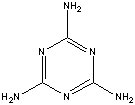
NTP Study Reports

NTP Study Reports
Home » Study Results & Research Projects » NTP Study Reports » All Long-Term Reports » Abstract for TR-245 - Melamine

| Chemical Formula: C3H6N6 | - | 3D Structure* |
|---|---|---|
| *To view structure, download free Chemscape Chime Plug-in | ||
A carcinogenesis bioassay of melamine (>95% pure), a chemical intermediate in the manufacture of amino resins and plastics, was conducted by feeding diets containing 2,250 or 4,500 ppm melamine to groups of 50 male F344/N rats and 50 B6C3F1 mice of each sex for 103 weeks. Groups of 49 male rats, 50 female rats, 49 male mice, and 50 female mice served as controls.
Mean body weights of dosed rats of each sex were lower than those of the controls after week 20. Survival of high-dose male rats was significantly lower (P<0.05) than that of the controls. Survival of all other dosed rat groups was comparable with that of the respective controls.
Transitional-cell carcinomas in the urinary bladder of male rats occurred with a statistically significant positive trend (P<0.002; controls, 0/45; low-dose, 0/50; high-dose, 8/49, 16%) and the incidence in the high-dose group was significantly higher (P<0.016) than that in the controls. A transitional-cell papilloma was observed in the urinary bladder of an additional high-dose male rat. These tumors were not observed in statistically significant proportions in female rats. Seven of the eight high-dose male rats with the transitional-cell carcinomas also had bladder stones. An association (P<0.001) was found between bladder stones and bladder tumors in male rats.
Chronic inflammation, distinguishable from the nephropathy observed in aging F344/N rats, was significantly increased (P<0.01) in the kidney of dosed female rats (controls, 4/50,8%; low-dose, 17/50, 34%; high-dose, 41/50, 82%) and is attributed to the administration of melamine.
The mean body weight of high-dose male mice was lower than that of controls after week 50 of the study. The mean body weights of dosed and control female mice were comparable throughout the study. Survival of high-dose male mice was significantly less (P<0.02) than that of the controls. Survival of all other dosed groups was similar to that of the respective controls.
Acute and chronic inflammation and epithelial hyperplasia of the urinary bladder were found in increased incidence in dosed male mice. The incidence of bladder stones in dosed male mice was increased relative to controls (control, 2/45, 4%; low dose, 40/47, 85%; high-dose, 41/45, 93%); however, there was no evidence of bladder tumor development in this species. Also, four high-dose female mice had bladder stones without any tumors.
Under the conditions of this bioassay, melamine was carcinogenic for male F344/N rats, causing transitional-cell carcinomas in the urinary bladder. With one exception, urinary bladder stones were observed in male rats that had transitional-cell carcinomas. Melamine was not carcinogenic for female F344/N rats or for B6C3F1 mice of either sex.
Levels of Evidence of Carcinogenicity: | ||
| Male Rats: | Positive | |
| Female Rats: | Negative | |
| Male Mice: | Negative | |
| Female Mice: | Negative | |
Synonyms: 2,4,6-triamino-s-triazine; cyanurotriamide
Report Date: March 1983
Target Organs & Incidences from 2-year Studies
You may link to the full technical report in pdf format ( Note: A print ready copy of the document is presented in Portable Document Format (pdf) which requires the Acrobat Reader plug-in -- download a free copy of the reader.)
Web page last updated on October 14, 2004
The National Institute of Environmental Health Sciences is one of the National Institutes of Health within the U.S. Department of Health and Human Services. The National Toxicology Program is headquartered on the NIEHS campus in Research Triangle Park, NC.